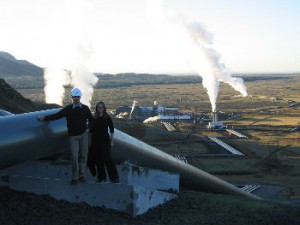The Hellisheidi Geothermal Plant, to the south of Reykjavik produces an effluent of CO<sub>2</sub> and H<sub>2</sub>S during the extraction of geothermal heat from the deep aquifer. The power utility (Orkuveita Reykjavikur) wants to minimize the CO2 emissions from geothermal production by dissolving liberated CO<sub>2</sub> into waste water from the power plant and reinjecting this water to an intermediate depth.
The ETG at Columbia has provided the geochemical characterization of the aquifer system and is involved in designing the monitoring system. During two successive fieldtrips we collected samples for SF<sub>6</sub> and CFC’s, <sup>3</sup>He, <sup>4</sup>He, Ne, Ar, Kr and Xe. My role in this project has been to sample for these tracers, measure the SF<sub>6</sub> and CFC samples and develop an estimate of residence time based on the information that the steady state and transient tracers provide. Helium isotopes were sampled to look at the interaction between the shallow, intermediate and deep geothermal reservoirs, and the noble gases were used to infer the recharge temperature. We are also attempting to use the noble gases to determine partitioning between the liquid and vapor phase, without assuming solubility equilibrium. Collecting samples from geothermal wells presents a specific set of challenges, due to the high temperatures and the mixture of steam and water that can exist at the wellhead. This work is in preparation with collaborators M. Stute, J. Matter, A. Wall and D. Fernandez.

